Social and economic development. Рубрика в журнале - Arctic and North
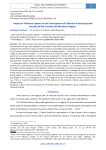
Статья научная
The article examines the impact of fish products export by fishermen of the Murmansk Oblast on the realization of two main indicators prescribed in the Food Security Doctrine: the volume of products supplied to the domestic market and their economic accessibility to the population. As a result of the study, it was found that the main indicator of the Doctrine implementation — the threshold value of fish products supply to the domestic market — is not met due to its excessive export. The level of under-supply, compared to the recommendations of the Doctrine, amounted to 53.4% in 2021. Fish is supplied to the Murmansk Oblast and other regions in volumes that ensure its sale at high wholesale prices set by fishermen and with little competition. The bulk of the Arctic fish catch — up to 75%, and over 90% of cod and haddock — is exported, which is facilitated by high world prices and the low rate of the Russian ruble. Even when Russian fish is sold abroad at a discount, fish producers prefer to export it. In the absence of incentives for the supply of fishery products to the domestic market, it is advisable to increase the legal status of the Doctrine and make the implementation of its recommendations mandatory, or change the rules for allocating fishing resources to economic entities. The economic availability of cut fish for the population of the producing region — the Murmansk Oblast — is lower than the Russian average. There is a declining level of consumption. This is a consequence of the use of high prices set in the domestic market in a non-market way. There is a need to establish prices for fish products on the domestic market using auctions or exchange trading.
Бесплатно
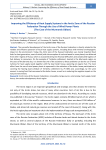
Статья научная
The successful development of the Arctic zone of the Russian Federation is directly related to the reliable and efficient operation of local heat supply systems, including those with minimal anthropogenic impact on the environment. Today, the Arctic zone of the Russian Federation uses mainly imported fossil fuels for heat generation, most of which (with the exception of coal and wood in some places) are delivered from other regions of Russia, which is associated with great financial difficulties and complicated logistics of fuel delivery to consumers. On the example of Teriberka settlement, located in the Murmansk region on the coast of the Barents Sea, it is shown that one of the solutions to these problems can be the use of wind turbines for heat supply needs together with the local boiler house, operating on organic fuel. The main effect from the use of wind power plants is expressed in the reduction of the boiler house participation in covering the heating load schedule of Teriberka settlement by 75-80% and, accordingly, by the same amount in saving fossil fuel consumed at the boiler house, as well as in reducing the negative impact on the natural environment.
Бесплатно
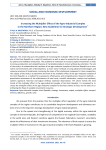
Статья научная
The article discusses the problems of increasing the multiplier effect of the agro-industrial complex of the Komi Republic as a result of investment, as well as ways to accelerate the economic growth of its spheres and individual enterprises. The problems of motivation to increase capital investments in order to increase production and competitiveness of marketable products remain without due attention. The aim of the study is to substantiate the transition of the agro-industrial complex of the Komi Republic to an innovative and investment path of development, to more active methods of using advanced technologies and resource provision of investments, increasing the share of the intellectual component in their composition. The subject of the study is to determine the level of the multiplier effect of the agro-industrial complex of the Komi Republic as a method for assessing its effectiveness and competitiveness. Research methods — quantitative assessment of the effectiveness of total costs, scientific abstraction, analysis and synthesis, systems approach, historical and logical method, statistical observations. The article reveals the main trends of the multiplier effect in the agro-industrial complex of the Komi Republic. It is proposed to increase the multiplier effect of the agro-industrial complex for business entities to focus on the tasks of coordinating the flows of available investment resources.
Бесплатно
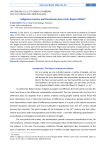
Indigenous tourism and the Barents Euro-Arctic Region (BEAR)
Статья научная
In this article, it is argued that indigenous tourism must be understood as shaped by European ideas of the Other, as well as a more recent development in global politics. Such broad and increasingly global structures frame those heterogeneous populations that are labeled and label themselves indigenous. Furthermore, the current situation of these peoples is also shaped by their relationships to surrounding majorities and nation states. Therefore, definitions of indigenous tourism should rather be built on minorities’ degree of control of tourism activities than by ideas of emblematic cultural features. The growth in the tourism industry in many parts of the Barents Euro-Arctic Region also represents an opportunity for representing and maintaining cultural features among minorities. Nevertheless, minorities might also face challenges by being relegated to a position in the tourism industry where other more powerful actors define a rather narrow field of what indigenous tourism is. This article is based on literary studies of contemporary research on indigeneity, tourism, and Sámi tourism and draws upon the author’s extensive previous research on Sámi tourism in Norway.
Бесплатно
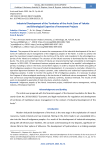
Статья научная
The purpose of the work is to assess the consequences of the industrial development of the territories of traditional nature management of the indigenous peoples of the North. In order to achieve the goal, the investment projects planned on the territory of the Arctic and considered in the ethnological expertise of the Yakutia are analyzed. The structure of the Yakutia economy is dominated by the mining industry. The Arctic and northern territories of Yakutia are characterized by high vulnerability to technogenic impacts. In 2012–2021, 39 investment business projects were considered in the republic’s ethnological expertise, including 12 ones in the Arctic and northern regions. In order to improve the health and quality of life of indigenous peoples in the areas of industrial development, it is necessary to conclude a trilateral Cooperation Agreement between the project customer, state authorities and authorized representatives of indigenous peoples. In order to monitor the quality of life of indigenous peoples, it is necessary to adopt the Program of ethno-ecological monitoring in the territories of traditional nature management. The study was carried out using historical-geographical, analytical, synthetic, statistical methods. The results of the work can be applied by specialists of state structures, scientists, students.
Бесплатно

Industrial Policy and Transformation of the Consumer Market of the Russia’s Arctic Regions
Статья научная
The article considers the state of industrial policy in the subjects of the Arctic zone of the Russian Federation both in terms of the status and dynamics of the regional consumer market and the mechanisms of state regulation and support. In the current situation of economic sanctions and external threats, the main problems of the consumer market are the following: rising prices, transformation of transport and logistics schemes, declining quality of goods and services, reduction of their assortment. Opportunities for solving them could include: location of production sites closer to the end consumer, inter-production and interregional cooperation and specialization, state regulation and compensation of fuel, energy and transport tariffs, infrastructure development. The article considers a number of generalized cases of consumer preferences formation depending on the goods belonging of local producers to this or that sector of the “Price x Quality” matrix. A number of systemic problems associated with the need for local producers to respond to the transformational changes to which the regional consumer market is exposed today has been identified. In order to create a set of support measures and effective tools, it is necessary to develop a system of long–term guidelines and strategizing in the field of regional industrial policy: on the one hand, it is integrated into the state vertical of industrial management, on the other hand, it takes into account territorial features, industrial potential and consumer expectations of the population in the regions. Based on the analysis, the authors propose to create a single document in each region of the Russian Federation with the working title “Fundamentals of regional industrial policy and consumer market development”.
Бесплатно
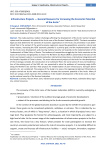
Infrastructure projects — general resource for increasing the economic potential of the Arctic
Статья научная
The study examines modern challenges affecting the development of the Arctic marine transport system and the economic situation of the Arctic zone of the Russian Federation (AZRF). The basic normative legal acts that determine the activities of economic organizations in the Arctic are presented. It was determined that in the context of the world economy regression caused by geopolitical, economic, natural and other reasons, increasing the AZRF economic potential is a priority goal, and the implementation of tasks for the Arctic zone development and ensuring national security corresponds to the implementation of the Fundamentals of State Policy of Russia. The tendency of competitive struggle by the Arctic countries on the issues of economics and geopolitics is noted. The Northern Sea Route (NSR) is presented as the basis of the Arctic sea transport system, its economic potential, international importance, international integration with the People's Republic of China is shown. The main infrastructural projects of the Arctic for the development of the oil and gas complex, the construction of an icebreaker fleet, the construction of new and modernization of the existing ports of the NSR, etc. are presented to solve the problems of increasing cargo traffic along the Northern Sea Corridor. New projects for modernization of port infrastructure, transport development, etc. are considered. The purpose of the study is to assess the ongoing and planned infrastructure projects carried out by the state and business to increase the economic potential of the Arctic. Many of them are unique, which expresses firm confidence in the modern development of the Arctic zone, in ensuring the national security of the Russian Federation.
Бесплатно
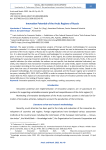
Innovation Potential of the Arctic Regions of Russia
Статья научная
The paper provides a comparative analysis of foreign and Russian methodologies for assessing innovation potential. It is shown that foreign methodologies cannot be used to determine the innovation potential of the Arctic regions of Russia due to specific indicators that are not calculated by Russian statistics. It is determined that the use of Russian methodologies for an objective assessment of the Arctic regions in terms of innovation potential is difficult. In this regard, the authors developed a comprehensive methodology for assessing innovation potential, the principal novelty of which consists, firstly, in the use of specific indicators (in other methods, the authors use not specific, but absolute statistical indicators); secondly, only indicators that characterize innovation development are used; thirdly, expert research methods are excluded. According to the results of the analysis of statistical data, it is determined that the Arctic regions have low rates of innovation development and lag behind the average Russian values. Based on the proposed methodology, the innovation potential was calculated and the Russian regions were ranked for ten years, including 2011, 2013, 2017 and 2020, in order to compare the dynamics of the Arctic regions. It is shown that the Arctic regions are characterized by rather low values of innovation potential and are mostly below 50th place in the ranking of Russian regions.
Бесплатно
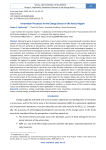
Innovation Processes in the Energy Sector of the Arctic Region
Статья научная
Moving forward, striving for perfection of any human activity is associated with innovative development of technologies, manufactured products, labor relations and other factors. The study presents the results of the joint activities of educational, scientific and industrial organizations in the energy sector of the country. It has been established that with the acceleration of scientific and technological progress, innovations and investment technological processes are becoming key components of government and business activities that contribute to the development of energy sector companies to ensure their long-term competitiveness, which is especially important when implementing Arctic projects. The importance of developing and creating an innovative technological product is especially acute in the energy industry that provides life support for people, businesses, and the country. The energy sector is a rather conservative industry in terms of innovations (this is due to the long life cycle of the main equipment, which is several dozens of years), created by domestic enterprises using exclusively domestic components. Modernization and construction of new facilities in the Arctic zone of the Russian Federation in the energy sector requires significant investments with long payback periods, which is a significant factor in decision-making. Small and medium-sized businesses operating in the energy sector are set to make a profit in the short or medium term, but such companies are characterized by a low level of research and development. Nevertheless, the reconstruction of the energy sector is an urgent topic for the industry today, due to the fact that the wear and tear of equipment exceeds its service life. The key results of investment activities and key trends in the development of the energy sector, including in the Arctic, are highlighted. The purpose of the study is to identify long-term trends in innovative technological solutions in various areas of the country’s energy sector and to determine methods for their application in Arctic projects.
Бесплатно
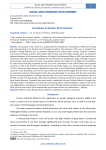
Innovations in Western Arctic Fisheries
Статья научная
The purpose of this article is to substantiate the possibility of increasing the efficiency of fishing and crab harvesting in the Western Arctic through innovation. The relevance of this issue is related to the decline in fishing efficiency due to sanctions imposed by the United States and the European Economic Community on fishing, as well as other factors that increase costs and reduce product value. An analysis of selected indicators of the economic efficiency of fishing in the Murmansk Oblast in 2021 was carried out in comparison with 2013, which is considered the last period of the development stage of fishing in accordance with the classic business life cycle. It was shown that the main impact on the decline in the efficiency of crab fishing and fishing in general was the loss of the crab market in the United States and European countries, as well as the need to reorient sales to the Asia-Pacific region. As a result, import prices for crab in China, Korea and Japan became significantly lower than in the United States ($40/kg) and in the EEU countries. It was found that prices for live crab in China are almost 3 times higher than for frozen crab, and an innovative system for delivering it to China alive was developed. It was shown that the main innovative factor in increasing efficiency in fishing is the new fleet. The use of new vessels for crab fishing will ensure a 20–50% increase in fishing results, while labor productivity in fishing should increase by about 2 times, and costs should decrease. Proposals have been made to potentially increase fishing efficiency through other innovative factors: introduction of a new catch accounting system, improved logistics, release of new products, digitalization, development of the domestic market through improved pricing and competition, etc. In 2024, prices for live crab in China reached their pre-sanction level in the United States — $40/kg.
Бесплатно

Innovative Potential of the Regions in the Russian Arctic Zone: State and Spatial Differentiation
Статья научная
The article considers the components of the innovation potential of Russian regions that are fully or partially included in the Arctic zone. The purpose of the article is to analyze and evaluate the state and dynamics of innovative development of the regions of the Arctic zone of the Russian Federation. The methodology for calculating the composite index of innovative development is proposed. The calculations are made on the basis of the database formed by the authors, which consists of four blocks; the main conclusions on the blocks are formed. According to the composite index for the period 2015-2021, the leading positions are occupied by the Krasnoyarsk Krai, the Arkhangelsk Oblast and the Komi Republic, and the Republics of Karelia, Sakha (Yakutia) and Komi in terms of the index growth rate. The study of the state, dynamics and level of innovation development in the regions of the AZRF shows that some components of innovation potential are unevenly developed in the regions that are fully or partially included in the AZRF. At the same time, the regions differ in the dynamics of innovative development. Thus, the worst indicators of innovative development in accordance with the proposed methodology are observed in the Arkhangelsk Oblast, Chukotka and Nenets Autonomous okrugs. The high correlation between the composite index of innovative development and indicators of socio-economic development of the regions revealed by the authors characterizes the positive impact of innovation activity on the socio-economic development of the AZRF subjects. In this regard, the key recommendations are the following: improvement of legislative support for the formation of eco-industrial, tourist zones, innovation sites and cluster formations in the Arctic territory within the framework of testing new formats of economic intensification of the Russian Arctic regions; formation of a macro-regional register of suppliers of innovative products for the projects of residents of the AZRF with the distribution of preferential measures of a special economic and administrative regime. The prospects of the research are related to the study of critical vulnerabilities in the production and technological processes of the sectors of specialization of the Arctic regions in import substitution.
Бесплатно

Статья научная
Ensuring the integrated processing of mineral raw materials remains a relevant topic of modern research due to its socio-economic, environmental and technological significance, as well as one of the key conditions for sustainable development of Russia, defined by the Strategy for the development of mineral resource base up to 2035. At the same time, the practical realization of this concept continues to be occasional and non-systemic. Under the new conditions of sanctions restrictions, the acute need for import substitution, taking into account the regional specifics of strategic mineral resources in the Arctic zone of the Russian Federation, it is necessary to change the paradigm of development of the resource and raw materials complex of Russia from extensive to intensive one and to shift the research context towards readiness of regional economic systems to such changes. Considering the accumulated scientific background, the article attempts to consolidate and systematize the research on the topic of integrated processing of mineral resources in relation to the factors that determine readiness and cause resistance to the practical implementation of the concept on the part of economic entities as key actors in this process. The scientific novelty of the study consists in the systematization of existing positions on the issue of transition to the implementation of the concept of integrated processing of mineral resources to develop a set of indicators as a tool for assessing the readiness and resistance of the regional economic system to the paradigm shift. The research method used is a review of publications on the topic of integrated processing of mineral resources. As a result of the study, 20 factors were identified and systematized into 5 groups. The obtained classification of factors can become the basis for further research of the question posed in this article, which will allow assessing the readiness for changes at the regional level, to identify obstacles that hinder their implementation, and to determine the directions of search for solutions to eliminating or levelling of the identified resistance factors.
Бесплатно

Статья научная
The team of authors of the article conducted a sociological study aimed at analyzing and assessing the interaction of enterprises in the real sector of the economy and organizations of higher and secondary education in the field of personnel training for the Arctic Zone of the Russian Federation using the example of the Arkhangelsk region. The results of the study allowed us to conclude that the growing shortage of specialists with higher and secondary vocational education in the shipbuilding, forestry and fishing industries of the Arkhangelsk region in recent years has stimulated the interest of enterprises in cooperation with educational organizations. The study revealed significant differences in the level of interaction by enterprise size. The most intensive cooperation between educational organizations is carried out with large enterprises planning staffing for the medium term, having the greatest personnel needs, as well as human and financial resources to build interaction in their interests. The study also showed a trend towards establishing long-term connections between educational organizations and large enterprises using a variety of cooperation tools and involving students in work activities during their studies with a view to subsequent employment. At the same time, quantitative and qualitative data indicate the vulnerable position of small and medium-sized enterprises in terms of cooperation with educational organizations and, as a consequence, the provision of personnel. This is due both to the limited human resource for planning personnel policy, and to the fact that the few educational organizations in the region, as a rule, give priority to cooperation with major players, due to their status and ability to provide material support to the educational institution.
Бесплатно
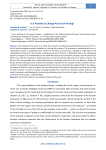
Is It Possible to Change Arctic Fish Pricing?
Статья научная
The purpose of the article is to show the necessity of reducing wholesale domestic prices for Arctic fish and to propose economic methods for solving this problem. The relevance is associated with an unreasonable increase in wholesale prices, which are the basis of retail prices, resulting in a decrease in the consumption of local fish. The increase in wholesale prices of fisheries in 2014-2015 and in the subsequent period is analyzed. The fundamentals of the world doctrines of cost and value are given, and the absence of factors to justify the increase in wholesale prices on the basis of the labor theory of value is shown. The data on the unreasonably close relationship between wholesale prices for fish in the domestic market of Russia and the exchange prices at which fish products exported to the European Union countries are presented. The possibility of reducing wholesale domestic prices by increasing the supply of fish to the domestic market of Russia in order to achieve the threshold values of the figures indicated in the Doctrine of Food Security is shown. In order to replace exchange foreign prices used in the domestic market of Russia, the need to develop a methodology for determining wholesale prices for the main types of Arctic fish, primarily currency-intensive ones, is substantiated.
Бесплатно
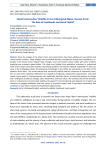
Статья научная
Since the collapse of the Soviet Union, local communities have been adapting to new political and socioeconomic realities. These changes have prompted dramatic outmigration among rural populations, es-pecially in the Russian Arctic. Despite these changes, some communities remain viable, with some residents exploring new economic opportunities. This study uses findings from qualitative interviews to understand what factors shape community viability, interviewing residents and relevant regional stakeholders in two case areas in the Arkhangelsk oblast: the Solovetsky Archipelago in the White Sea and islands in the delta of the Northern Dvina River. The results indicate that community viability and the reluctance of community mem-bers to leave their traditional settlements are shaped by livelihoods, employment opportunities, and social capital. Social capital is characterized by such empirically identified factors as shared perceptions of change and a willingness to address changes, place attachment, and local values. We conclude that further develop-ment or enhancement of community viability and support for local livelihoods also depends on 1) bottom-up initiatives of engaged individuals and their access to economic support and 2) top-down investments that contribute to local value creation and employment opportunities.
Бесплатно
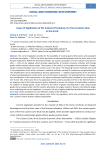
Issues of Application of the Customs Procedure of a Free Customs Zone in the Arctic
Статья научная
The current regulation provides for the possibility of creating special (free) zones and equivalent territories (hereinafter — SEZ) in the Arctic (territories of advanced development and the Arctic zone of the Russian Federation). Within the framework of SEZs, the customs procedure of a free customs zone (hereinafter — FCZ) can be applied, which provides opportunities to conduct economic activities with foreign goods without paying customs duties. The purpose of the study is to investigate the peculiarities of applying the customs procedure of a free customs zone in the Arctic. The following research methods were used in the preparation of the article: economic, analytical methods, method of comparison and generalization. This simplification can be demanded by Russian organizations — residents (participants) of the territories of advanced development and the Arctic zone of the Russian Federation. The proposed article is devoted to the consideration of the mechanisms of the above-mentioned simplifications provided for the residents of the “Arctic” SEZ. At the same time, the application of the customs procedure of FCZ in the SEZ territories is an important tool of the state economic policy, designed to ensure the creation of comfortable conditions for taxation of foreign goods. Issues related to the status of goods manufactured in SEZs using foreign goods that are placed under the FCZ customs procedure are largely related to Russia’s international obligations underlying the current regulation. In practice, the set of legally established simplifications analyzed in the article creates conditions for more effective activity of SEZ residents.
Бесплатно
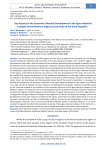
Статья научная
The article presents a scientific approach to the actual problem of the formation of a full-fledged economic potential (industrial and consumer) of the agro-industrial complex of the northern regions. The key premise of the study is that the content of the economic potential makes it possible to identify not only the dynamics of the accumulation of production capacities, but also to determine the trends and prospects for socio-economic, environmental, infrastructural, demographic and market transformations. The principle of conducting a systematic analysis of the state, composition and structure of the agro-industrial complex of the regions of the North of potential was chosen as the main prerequisite for the study. The most reliable method that reveals the directions of the prospective development of the agro-industrial complex of the regions of the North is a retrospective analysis of the state of their technical, economic and other indicators. Given the interrelated and interdependent properties of the economic potential, it is proposed to develop the production and consumer potentials of the agro-industrial complex of the regions of the North in a single context of relevant economic relations and development strategies. Emphasis should be placed on the constant renewal of the elements of the economic potential of the agro-industrial complex of the Northern regions. An important role in increasing the economic potential of the agro-industrial complex of the Northern regions should be played by the formation of regular state financial, economic, legal and other support for the agro-industrial complex of the regions of the North. The long-term strategic line for the development of the agro-industrial complex of the regions of the North should be determined not only by the level of production and sales of marketable products, but also by the combination of state and non-state program measures into a clear and coordinated effective system of strategic measures. It is recommended to regularly transform the elemental structures of the agro-industrial complex of the Northern regions from a passive state into an active carrier of intellectual capital, fixed assets and investments.
Бесплатно
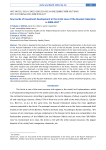
Key trends of investment development in the Arctic zone of the Russian Federation in 2008–2017
Статья научная
This article is devoted to the study of the investments and their transformation in the Arctic zone of the Russian Federation in the conditions of the crisis of the last decade. Current studies indicate the occurred as a result of economic shocks aimed at the implementation of the state Arctic policy, as well as the need for financial and technological constraints that require a retrospective analysis of investment activity in the Arctic zone. The study of investments in the Arctic zone of the Russian Federation in 2008-2017 has four stages identified: 2008–2010; 2011–2012; 2013–2014; 2015–2017. One may see that investments in the Russian Federation are due to quite sharp fluctuations and their uneven distribution across regions. The most significant volumes of Russian investments in the first phase were typical for regions partially located in the Arctic zone of the Russian Federation, and now — for entirely Arctic areas. The same situation was until 2014 with foreign investments in the Arctic. However, after the start of the “sanctions war,” we observed a turning point. Foreign investments in the Arctic areas of the Russian Federation significantly decreased. The decline continues to this day. Predicted options for further investment development in the Arctic zone of the Russian Federation have an adverse scenario for the national economy.
Бесплатно
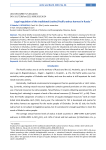
Legal regulation of the traditional (native) Pacific walrus harvest in Russia
Статья научная
The article briefly reviewed studies of the Pacific walrus. This information is necessary for the development of the Total Allowable Catch (TAC) since the native people of Chukotka annually harvest this subspecies of walrus. We have drawn attention to the long-term change in the habitat of the walrus, i.e., to the reduction of the ice period in the Bering and Chukchi Seas and possible consequences for the walrus (increased mortality and epizootics). Legal acts for the fisheries are regulating the traditional (native) walrus harvest on Chukotka, and the capture of walrus calves for educational and cultural purposes have been described. A scheme for the development of the TAC for walrus has been discussed as well. We have presented the latest data on allocated quotas and actual walrus harvest. The need for more detailed and versatile research of walrus in connection with climate change is discussed. The author suggests cooperation between the native people of Chukotka and various research institutions for the better-organized study of the walrus in relation to climate change, for conservation and rational use.
Бесплатно
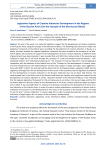
Статья научная
The aim of the work is to study the legislative support for the development of creative industries in the Russian Arctic using the example of the Murmansk Oblast. The following tasks have been solved: the legislative framework of the federal level, providing the development of creative industries in Russia as a whole, has been studied; the regional legislative framework has been studied on the example of the Murmansk Oblast; the measures of support for the development of Arctic creative industries at different levels of government have been analyzed. It was revealed that until 2021 the creative sector of the economy was reflected in legal acts of all levels through the concepts of “small and medium-sized businesses”, “self-employed citizens” and “individual entrepreneurs”. The concept of “creative industries” received legislative recognition with the adoption at the federal level of the “Concept for the development of creative industries and mechanisms for the implementation of their state support in large and major urban agglomerations until 2030” in 2021. The Concept and the Action Plan for its implementation, adopted in 2030, laid the regulatory and legal basis for the development of this sector of the economy, but the legislative framework for the development of creative industries in the Russian Federation has not yet been fully formed. The study showed that in the Arctic zone of the Russian Federation the situation with regulatory support for the development of creative industries is similar. Using the example of the Murmansk Oblast, it was revealed that the regional legislative framework for this promising area is currently in the nascent stage, and the first normative-legal acts directly related to the development of the Arctic creative industries began to appear only in 2023. It was concluded that it is necessary to develop a concept for the development of Arctic creative industries in the Russian Arctic in order to ensure uniform approaches, consistency of actions and coordination of measures for the development of this sector of the economy in the Russian Arctic. The need to use the term “creative industries” in various legal acts in order to avoid discrepancies and to ensure the uniformity of legal support for this sector of the economy is substantiated.
Бесплатно

